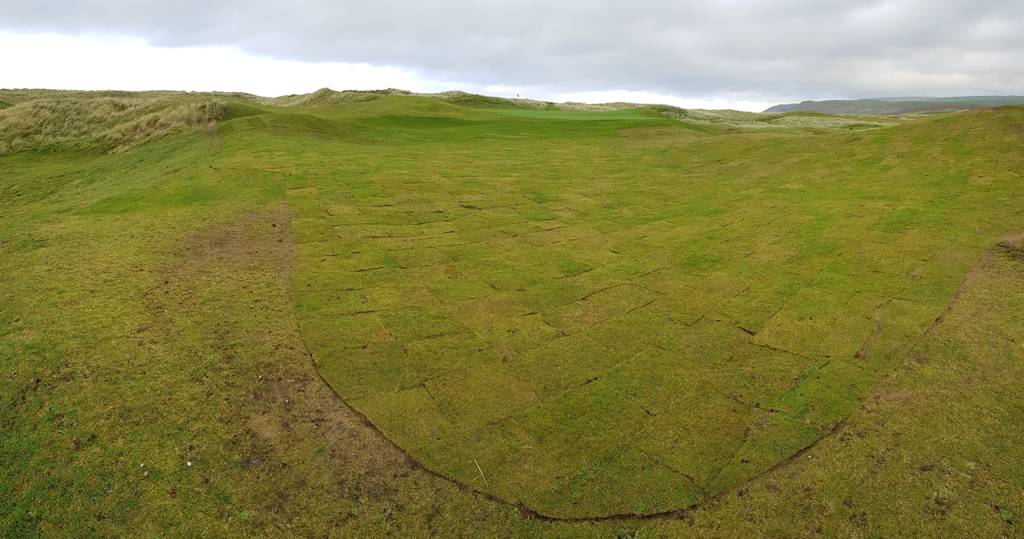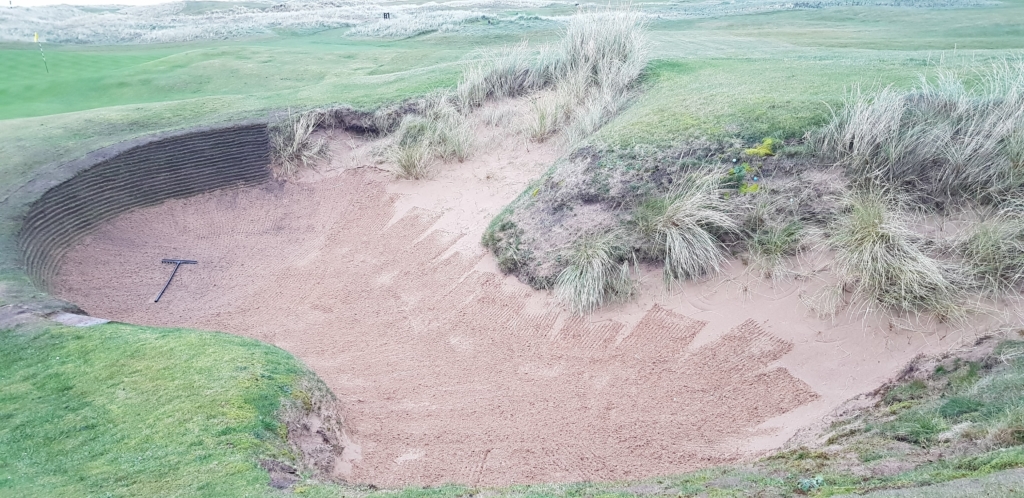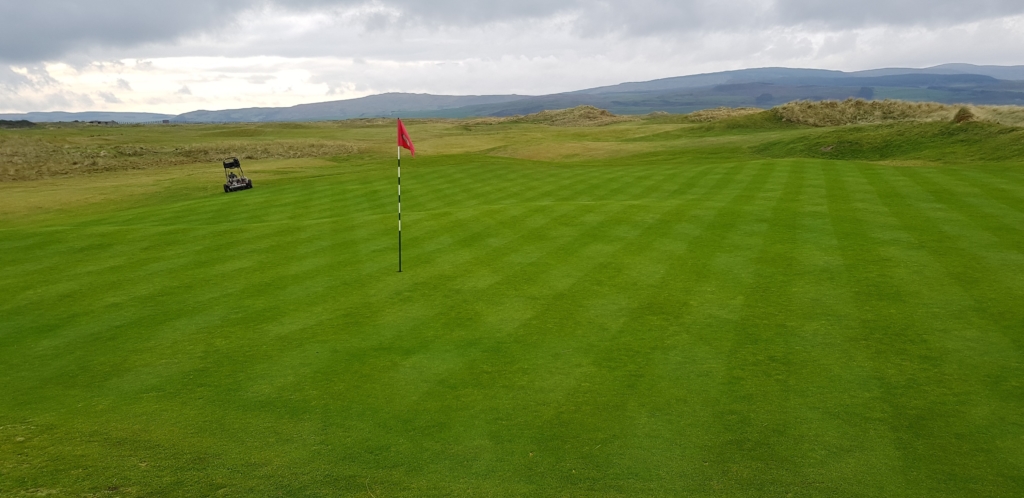…but that is just what we always get at this time of year on the west coast, as the vicious Atlantic low-pressure systems that can be accelerated by the jetstream repeatedly career into us head-on until they find themselves blocked by high pressures that sneakily creep in from Scandinavia. The tabloid press loves this time of year. For weeks now, we have been rolling our eyes at headlines that one week promise “arctic blasts and polar vortexes” and the next tell us that “Scotland is basking in soaring temperatures and it is warmer in Glasgow than it is in Tenerife”. Those of us who study the weather know that these fluctuations in fortunes are nothing new, it has always been thus in November and December.
While we get a kick out of bashing the media for their attention-seeking ways, we do have to be constantly aware of the effect that these extremes in weather conditions have on the condition of our turf. It is all too easy to be smug as we watch a weak bit of turf slowly recover during an unseasonably warm spell, but that recovery will immediately cease if the wind does start to blow from the east. We have learned over the years to make sure that we never take our eye off the ball, and we constantly study forecasts in an attempt to ensure that we do not miss any opportunity to protect and improve the health of our surfaces. A good way to gauge whether or not we have done this effectively is to assess our mood towards the current conditions. If I am moaning about the weather at this time of year it usually means I have misjudged something along the line, but if you approach me and ask if current conditions are suiting me and I tell you that they are, then that probably means that things are generally looking quite passable!
Winter Renovation Work
The best thing about being a greenkeeper in the U.K. is that we have two jobs for the price of one. Just when we are getting absolutely sick of cutting grass and implementing the weekly programs that produce optimum playing conditions, the growth slows down and construction season begins. We had some ambitious plans for this winter, and we have been forging ahead with this work.
The first project that we got stuck into was the reshaping of the bunkers at the 15th. The two bunkers to the right side of the fairway had long ago begun to fall in and had lost so much sand to windblow that they had become almost unplayable. As everybody knows, the ground on which Machrihanish Dunes sits is a site of special scientific interest, so unlike most links courses, we cannot simply hack randomly into dunes with an excavator to obtain an endless supply of sand to top these bunkers back up. What we have done at the 15th is to re-contour the area where the two bunkers previously sat, filling in the front one and reshaping the rear one in such a manner that it will catch the vast majority of balls that run anywhere within its vicinity.

The third bunker (the one closest to the green) was reshaped to flatten its base and make it a lot fairer than it was previously. Both of these bunkers have been revetted to ensure that they retain sand far more effectively than they did previously.
When we undertake a project such as this, we are always extremely careful to ensure that things go back down in the same way as they are lifted. Not only do we lift the turf off the area, but we also strip and stockpile the “soil” from under that before contouring the underlying sand. Once we have achieved the exact shape we require in the sand, we replace an even layer of the soil before replacing the turf. Matching the soil profile and the turf to that of the surrounding area during construction ensures that the restored ground will look and react the same as the ground around it, and most importantly, will continue to favour the exact same species of plants. The last alteration we made was to replace the turf on an area of green surround which had suffered serious damage during the dry spell last summer. This area had been artificially shaped when the green was originally built but was turfed straight onto sand, so we took a sample of the surrounding ground to ascertain the depth of soil in that area before removing that depth of sand and replacing it with composted soil that we produce for ourselves.
It is a common misconception that natural links courses are “built” on sand. Sure, the rootzone is light and free-draining but the “soil” that grows under the fairways is darker in appearance and is capable of holding more nutrients and water than the sand below it. The reason it is like this is because over a long period of time, plants have shed organic material which has been composted and added to the soil profile while grazing animals simultaneously added their own natural “fertiliser”,. Over time, this boosted rootzone develops into an ideal medium upon which to grow links grasses. It sheds water easily, it is bacterially rich ,and it contains exactly the right blend of nutrients to ensure the survival of the grasses that we want to encourage. It may just look like dark sand, but there is a lot more to it than that. When we undertake renovation projects, we need to replicate this rootzone. To do this, we collect all the turf that we remove from the golf course during renovation projects and dump it in a heap off-site. We leave this to compost down over a period of one to two years, turning it over occasionally when we have a digger on hire to allow air to circulate through it. The bacteria that go to work on the turf to break it down thrive as they go about their task and multiply countless times before the heap is eventually ready for us to use. What we are left with is absolute gold for a turf manager: a pile of free draining soil containing just the right blend of nutrients and absolutely teeming with life. The roots of the turf that we place on top of that mixture cannot wait to grow into it and make use of its resources. Composting decaying turf into a free heap of soil is one of the most satisfying things I do as part of my job, as I know that I am creating growing material which is absolutely in keeping with what is already present on the site—and I haven’t had to pay a single penny for it!


The other major project we took on this winter was to re-contour the front of the green surround at the 17th. This area was shaped when the green was rebuilt a few years ago, but the general feeling was that the result was a bit harsh, especially given the sadistic nature of the hole in general. I always considered that it was fair enough to be punished for missing the green to the right, but that it was rotten to also make life difficult for people who had finished short. What we have done is simply flatten out the surround to ensure that balls landing short of the green kick towards rather than away from the green. This will allow golfers whose balls come to rest in this re-contoured area choose how to play their next shot rather than to be faced with an almost impossible flop shot off a tight lie. Once again, we have ensured that the rootzone we laid on top of the underlying sand is a perfect match for the ground surrounding it, because we need the replaced turf to react and grow in exactly the same way as it did before. In this instance, we simply stockpiled and then replaced the existing soil to an even depth and turfed over the top of that.

Bunker Renovations
There are very few bunkers left on the course that have not been renovated in the last couple of years, but typically it is the most difficult jobs that are still outstanding. We want to be sympathetic to the original idyll of leaving the bunkers with a wild look but in most instances, this is totally impractical as the wind here is so ferocious that the sand simply blows out of them or gets blown into the thick marram from where it is very difficult to retrieve. Most of the bunkers we have left to renovate in our schedule have areas which have been “undercut” by the wind, so we feel forced to repair these by revetting them. Sometimes though, there are wild sections that can be retained. If these areas orientate in such a way that the wind does not unduly affect them, or if they have been “built” steeply enough in the first instance, it is possible that bunkers or sections of bunkers can be left with a natural appearance. We are always keen to do this if the bunker we are working on faces into the rough, but sometimes even bunkers surrounded by cut grass can look better if some of their wildness is retained. This bunker at the 7th is a good example of how a mixed, seemingly random approach to renovation can actually work quite well in the right environment. Malcolm has clinically revetted the front face, because this had become severely undercut and was falling in. The marram has been retained on the right side, because its root system supports the high bank that it grows in. That bank is so steep and the orientation of the hazard is such that the sand does not blow up and out of the bunker on this side. The rear bank of the bunker has been turfed with chunks. This is our least preferred option, but the bank here is so high and was becoming so eroded that we had to do something with it. If we had revetted it, we would have had to build many layers, and the height of the bank would have made it very difficult to mow. We could not plug this bank with marram because it is in the line of play and balls entering the bunker would have got caught up in the long grass. By planting thick chunks of mossy, slow-growing turf straight onto the sand, we created a steep face that increases sand retention and halts erosion but minimises the maintenance required. In some instances, “chunked” banks never need to be mown at all, which is obviously very welcome given the maintenance headaches that steep banks cause us. The obvious downside to chunked banks is that they can be quite fragile if subjected to foot traffic, so they can only be used in areas like this where that will not be an issue.

The Golf Never Stops!
Just because we have been busy doing renovation works does not mean we have forgotten about trying to produce decent playing surfaces! Even though I have spent the majority of the last three months moaning about turf disease, the effects of these pathogenic disorders did not become pronounced enough to have a negative impact on putting surfaces. Now that the greens have had enough time to recover from that onslaught, they actually look quite good for the time of year and were playing pretty well for the 55 golfers who turned out to play in our inaugural Winter Open on 1 December. This competition was won by Jonathan Bruce with an excellent total of 41 points. The monthly medals continue to be played (usually on the last Sunday of the month) off the yellow tees with a CSS of 69, and the winter league is in full swing. For those of you who may not be aware, you can enter a card for the winter league on any day of the week, but obviously, only one card per week (your best one!) will be counted towards your total. Historically, the winter league has been blighted by poor weekend weather, so this new option gives people who have a day off during the week the opportunity to come down and make the most of any decent conditions that we do get.
That’s about all I’ve got for this month. I hope you all enjoy the festive season!


